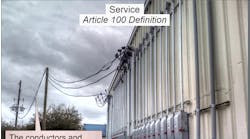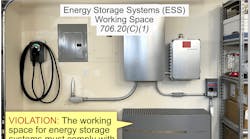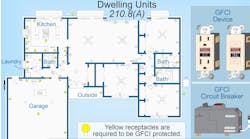Article 695 covers the electric power sources and interconnecting circuits for electric motor-driven fire pumps. It also covers switching and control equipment dedicated to fire pump drivers. Article 695 does not apply to sprinkler system pumps in one- and two-family dwellings or to pressure maintenance (jockey) pumps.
A general philosophy in the Code is to provide circuit overcurrent protection that shuts equipment down before allowing the supply conductors to overheat and become damaged from overload. Article 695 departs from this philosophy. The idea is that the fire pump motor must keep running no matter what.
Because the pump supplies water to a facility’s fire protection piping, which, in turn, supplies water to the sprinkler system and fire hoses, it is better to sacrifice the fire pump rather than the entire structure. This Article contains many requirements to maintain an uninterrupted supply of water.
Some of the requirements of Art. 695 seem wrong at first glance, until you remember why that fire pump is there. For example, the disconnect must be lockable in the closed position. You would normally expect it to be lockable in the open position because other Articles in the Code require that for the safety of maintenance personnel. However, the fire pump runs to ensure the safety of an entire facility and everyone within. For the same reason, fire pump power circuits cannot have automatic overcurrent protection against overloads. The intent of this Article is to allow enough time for building occupants to escape and (if possible) to save the facility.
Power sources
Power to fire pump motors must be supplied by a reliable source that has the capacity to carry the locked-rotor current of the fire pump motor(s), pressure maintenance pump motors, and the full-load current of any associated fire pump equipment [Sec. 695.3(A)]. Specifically permitted reliable sources of power include a [Sec. 695.3(A) and (B)]:
An alternate source of power is not required where a backup engine-driven, steam turbine-driven, or electric motor-driven fire pump with an independent power source per Sec. 695.3(A) or (C) is installed [Exception to Sec. 695.3(B)(1) and (B)(2)].
Transfer of power to the fire pump controller must take place within the pump room [Sec. 695.3(F)].
Disconnects
A single means of disconnect can be installed between the fire pump electric supply and a [Sec. 695.4(B)(1)(a)]:
(1) Listed fire pump controller,
(2) Listed fire pump power transfer switch, or
(3) Listed combination fire pump controller/power transfer switch.
Overcurrent protection
The requirements for overcurrent protective device (OCPD) selection have been heavily changed with the 2020 NEC. OCPDs for individual sources must be selected or set to carry indefinitely the sum of the locked-rotor current of the largest fire pump motor and 100% of the full-load current of the other pump motors and fire pump’s accessory equipment [Sec. 695.4(B)(2)(a)(1)].
Overcurrent protection must be listed for fire pump service, not have a field adjustable trip setting, and not open within [Sec. 695.4(B)(2)]:
- Two minutes at 600% of the full-load current of the pump motor(s).
- 10 minutes at 300% of the full-load current of the pump motor(s).
It also must not open with a re-start locked-rotor current of 24 times the full-load current of the pump motor(s).
Do you have OCPDs between an on-site standby generator and a fire pump controller? If so, size them to allow for instantaneous pickup of the full pump room load, but do not exceed the value selected from Sec. 430.62 to provide short-circuit protection only. If the locked-rotor current value does not correspond to a standard OCPD size, then use the next larger standard OCPD size per Sec. 240.6.
The following example will help you better understand these requirements.
Example: What size OCPD and conductor do you need for a 25-hp, 460V, 3-phase fire pump motor that has a locked-rotor current rating of 183A? (Fig. 2)Solution:
Locked-Rotor Current = 183A
Protection Size = 200A [Sec. 240.6(A) and Sec. 695.4(B)(2)(a)(1)]
Determine the branch-circuit conductor at 125% of the motor’s FLC [Table 310.16, Sec. 430.22, and Table 430.250].
Branch-Circuit Conductor = 34A × 125% = 42.50A
Therefore, use an 8 AWG conductor rated 50A at 75°C [Sec. 110.14(C)(1)(a)(3) and Table 310.16].
Transformers
If a transformer supplies an electric fire pump motor, then size it at least 125% of the sum of the fire pump motor(s) and pressure maintenance pump(s) motor loads, and 100% of the ampere rating of the fire pump’s accessory equipment [Sec. 695.5(A)].
Size the primary OCPD(s) to carry indefinitely the sum of the locked-rotor current of the fire pump motor(s) and pressure maintenance pump motor(s), and 100% of the ampere rating of the fire pump’s accessory equipment. Secondary overcurrent protection is not permitted. The requirement to carry the locked-rotor current indefinitely does not apply to fire pump motor conductors [Sec. 695.5(A)].
Power wiring
Service conductors and conductors supplied by on-site power production facilities must be physically routed outside buildings [Sec. 695.6(A)(1)]. Where supply conductors are run inside the building, they must be encased in 2 in. of concrete or brick [Sec. 230.6].
Exception: Supply conductors within the fire pump room are not required to be encased in 2 in. of concrete or brick as required by Sec. 230.6(1) or (2).
Informational Note: See Sec. 250.24(C) for routing the grounded conductor to the service equipment.
Fire pump supply conductors must [Sec. 695.6(A)(2)]:
- Be kept entirely independent of all other wiring.
- Supply only loads directly associated with the fire pump system.
- Be protected from potential damage by fire, structural failure, or operational accident.
Fire pump conductors routed through a building must be protected from fire for 2 hr using any of these methods:
(a) Encasing the cable or raceway in at least 2 in. of concrete.
(b) Using a cable or raceway that is a listed fire-resistive cable system.
(c) Using a cable or raceway that is a listed electrical circuit protective system.
Exception: The feeder conductors located between an electrical equipment room and fire pump room are not required to have 2-hr fire protection unless otherwise required in Sec. 700.10(D).
Conductor size
Conductors supplying fire pump motors, pressure maintenance pumps, and associated fire pump accessory equipment must have a minimum ampacity of at least 125% of the sum of the fire pump motor(s) and pressure maintenance motor(s) full-load current(s), and 100% of the associated fire pump accessory equipment [Sec. 695.6(B)(1)].
Conductors supplying only a fire pump motor must have a minimum ampacity of at least 125% of the motor full-load current rating per Sec. 430.22 and must comply with the voltage-drop requirements in Sec. 695.7 [Sec. 695.6(B)(2)] (Fig. 3).Wiring
Wiring from the fire pump controllers to the fire pump motors must be in rigid metal conduit, intermediate metal conduit, electrical metallic tubing, liquidtight flexible metal conduit, liquidtight flexible nonmetallic conduit, listed Type MC cable with an impervious covering, or Type MI cable. The connections in the motor terminal box must be made with listed devices. Twist-on, insulation-piercing type, and soldered wire connectors are not allowed [Sec. 695.6(D)].
Ground-fault protection of equipment (GFPE) is not permitted in the fire pump power circuit [Sec. 695.6(G)].
Where raceways or cables terminate at a fire pump controller, the following requirements apply [Sec. 695.6(J)]:
(1) Raceway or cable fittings must be listed and identified for use in wet locations.
(2) The enclosure-type rating of the raceway or cable fittings must be at least equal to that of the fire pump controller.
(3) The installation instructions of the manufacturer of the fire pump controller must be followed.
(4) Alterations to the fire pump controller, other than raceway or cable terminations, must be approved by the AHJ.
Voltage
The voltage at the line terminals of the fire pump controller is not permitted to drop more than 15% below the normal (controller-rated) voltage under motor starting conditions [Sec. 695.7(A)].
The voltage at the load terminals of the fire pump controller is not permitted to drop more than 5% below the voltage rating of the motor connected to those terminals when the motor operates at 115% of the fire pump motor full-load current rating [Sec. 695.7(B)].
Under pressure
Fire pump installations differ from other types of installations for one important reason you must always keep in mind: That pump must run, even if it will overheat. That “carry indefinitely” clause exists because you can’t have the pump shutting off when it’s critical to maintain water pressure in the fire protection system. Save the people, burn the pump — not the other way around.
These materials are provided to us by Mike Holt Enterprises in Leesburg, Fla. To view Code training materials offered by this company, visit www.mikeholt.com/code.
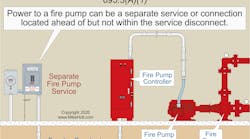
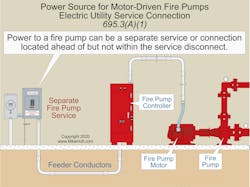
![Fig. 2. If the locked-rotor current does not correspond to a standard overcurrent device, use the next size up [Sec. 240.6(A)]. Fig. 2. If the locked-rotor current does not correspond to a standard overcurrent device, use the next size up [Sec. 240.6(A)].](https://img.ecmweb.com/files/base/ebm/ecmweb/image/2020/09/Figure_2_Code_Basics_10_20.5f739780522a7.png?auto=format,compress&fit=max&q=45&h=188&height=188&w=250&width=250)



